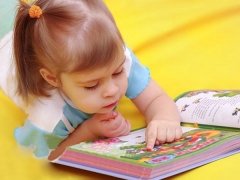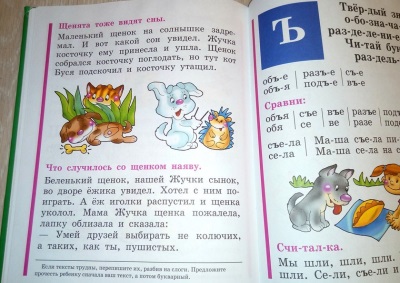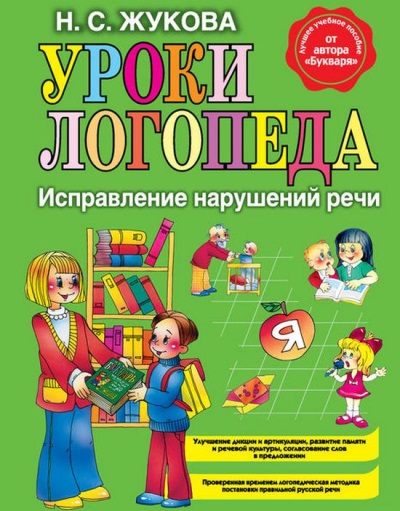Learning to read according to the method of Nadezhda Zhukova
Among the huge choice of methods, teaching reading according to the method of Nadezhda Zhukova is very popular. Her method is adapted for self-study of parents with children at home. Teaching aids N. Zhukova acceptable cost, they can be purchased in almost all bookstores. Let's try to figure out what is special about this method and why it is so popular.
From biography
Nadezhda Zhukova is a domestic teacher who is familiar to many, a candidate of pedagogical sciences and has a great speech therapy experience. She is the creator of a whole series of educational literature for children, which is published in millions of copies. Many of her scientific works have been published not only in Russian, but also in specialized publications of other countries.
Nadezhda Zhukova conducted many studies with preschool children, carefully studied the progressive processes of the development of their speech. She created a unique technique by which children can quickly learn to read and easily move from it to writing. In his methodology, N. Zhukova teaches children to correctly fold syllables that are used in her as a single part in reading and writing later.
Sales of its modern "Primer" surpassed the number of 3 million copies. From these figures, according to statistics, we can conclude that every fourth child learns to read precisely on it. In 2005 he was awarded the title of "Classic Textbook".
In the 1960s, Nadezhda Zhukova was an active worker in the initiative group, which dealt with the issues of creating specialized groups for children who have problems and disorders of speech activity. Now such speech therapy groups and whole kindergartens with this bias are widespread not only in our country, but also in the CIS countries.
Features of the technique
In creating her own special method, N. Zhukova used her 30-year-old speech therapy work experience. She was able to build a successful combination of literacy training with the ability to prevent mistakes made by children when writing. The textbook is based on the traditional approach to teaching reading, which is complemented by unique features.
In speech activity, it is psychologically easier for a child to identify a syllable than a separate sound in a spoken word. This principle is used in the technique of N. Zhukova. The reading of syllables is proposed already in the third lesson. Due to the fact that at the very beginning of learning to read this process for children is a mechanism for reproducing the letter model of the word into the sound one, the kid should already be familiar with letters by the time of learning to read.
Learning with the child all the letters of the alphabet at once is not worth it. The first acquaintance of the baby should be with vowels. Explain to the baby that the vowels are singing letters, you can sing them. Begin by learning the so-called hard vowels (A, U, O). After the baby has become acquainted with them, it is already necessary to start folding: AU, AO, OU, UA, UO, OA, OU. Of course, these are not syllables, but it is on such a combination of vowels that the principle of syllable addition is the easiest to explain to the little one. Let the kid himself, helping himself with his finger, draw paths from letter to letter, singing them. So he can read the combination of two vowels. Then you can begin to memorize consonants.
Then, when you begin to teach the crumb to read, explain to him how to determine by hearing how many sounds or letters you have pronounced, what sound in the word sounds first, last, second. Here you can be assisted in learning the Magnetic Alphabet by N. Zhukova. With its help, you can ask your child to lay out the syllables pronounced by you.
You can also feel the letters, stroke them with a finger, which will contribute to their tactile memorization. When the crumb learns to merge syllables, you can offer him to read a word of three letters, a word of two syllables. (O-SA, MA-MA).
In “Bukvare” Zhukova, parents will be able to find mini-summaries of lessons on the study of each letter, recommendations for learning syllable folding. Everything is written in accessible language. In order to use them, it is not necessary for parents to have a pedagogical education. Absolutely any adult can conduct a lesson.
Important tips
Teach your child in a playful way.
Preschooler is able to perceive information only in the form of a game. A game for him is a calm environment where no one will scold him or criticize him. Do not try to force the child quickly and immediately. read by syllables. For him, reading is not an easy task. Be patient, show affection and love for the child during training. He is now more important than ever. Showing calmness and confidence, learn to put syllables, simple words, sentences. The child must master the technique of reading. This process is not quick and difficult for him. The game diversifies learning, eliminates the boring duty to engage in, will help instill a love of reading.
Starting age
Should not rush things. It is quite normal that a 3-4-year-old child is not yet able to learn. At this age period, you can start classes only on condition that the child shows a great interest in reading activity, shows a desire to learn to read.
A 5-6-year-old child will take it differently. In preschool institutions, training programs are designed to teach children to read syllables. However, not always kids can learn the information obtained in a large team. Many children need individual lessons in order for them to understand the principles of folding syllables and words. So do not miss the opportunity to work with your child at home. Having come to school well-prepared, it will be easier for the kid to move the adaptation period.
It is important to take into account the psychological readiness to learn to read. Children are ready to start reading only if they already speak well, Correctly make sentences in his speech, phonemic hearing is developed at the proper level. Children should not have problems with hearing and sight, speech problems.

Sounds or letters?
Acquaintance with letters should not begin with memorizing their names. Instead, the child should know the sound that is recorded in one letter or another. No EM, ER, TE, LE, etc. should not be. Instead of EM, we learn the sound “m”, instead of BE, we learn the sound “b”. This is done to make it easier for the child to understand the principle of folding syllables. If you learn the names of the letters, then the child will not understand how the word PAPA is obtained from PE-A-PE-A, from ME-A-ME-A - the word MAMA. He will not add sounds, which are denoted by letters, but how he learned - the names of letters and, accordingly, he will read PEAPEA, MEAMEA.
We learn correctly vowels and consonants
Do not start learning the letters in alphabetical order A, B, C, D ... Follow the sequence given in the "Bukvare".
First of all, learn the vowels (A, O, U, U, E). Next, the student should be introduced to the firm voiced consonants M, L.
Then we get acquainted with deaf and hissing sounds (K, P, T, W, W, etc.)
In the "Bukvare" N. Zhukova proposed the following order of learning the letters: A, U, O, M, C, X, R, W, S, L, N, K, T, I, P, Z, Y, D, B, D, B, F, E, b, i, yu, y, h, e, t, f, y, b.

We fix the studied material
The repetition of the previously studied letters in each lesson will contribute to a more rapid development of the mechanism of literate reading in children.
Syllable reading
When you and your child learn a few letters, it is time to learn to add syllables. The cheerful boy helps with this in “Bukvare”. He runs from one letter to another, forming a syllable. The first letter of the syllable must be pulled until the baby has a finger on the path that the boy is running on. For example, the syllable MA. The first letter M. We put a finger at the beginning of the track near it. We pull the sound M while we run our finger along the path, without stopping: MMMMMMAAAAAAAAA. The child must learn that the first letter stretches until the boy runs to the second, as a result, they are pronounced together, not looking up from each other.
We start with simple syllables
The child must understand the algorithm of folding syllables from sounds. For this, he needs training first on simple syllables, such as MA, PA, MO, PO, LA, LO. Only after the child understands this mechanism, learns to read simple syllables, it is possible to proceed to the syllables more difficult - with hissing and deaf consonants (ЖА, ЖУ, ШУ, ХА).
Learning to read closed syllables
When a child learns to fold open syllables, it is necessary to begin learning to read closed syllables, i.e. those with a vowel in the first place. AB, CSS, UM, OM, AN. Such syllables for a child are much more difficult to read, do not forget about regular training.
Reading simple words
When the child understands the folding mechanism of syllables, begins to read them with ease, it comes time to read simple words: MA-MA, PA-PA, SA-MA, KO-RO-VA.
Watch for pronunciation and pause
In the process of learning to read, you must carefully monitor the pronunciation of the child. Pay attention to the correct reading of the endings of words, the child should not guess what is written, but read the word to the end.
If at the initial stage of training you taught the child to sing syllables, now, it comes time to do without it. Make sure the child pauses between words. Explain to him what the punctuation marks mean: commas, periods, exclamation marks and question marks. Let at first the pauses between the words and sentences that the baby makes be long enough. Over time, he will understand and shorten them.
By following these simple rules, you can teach your child to read pretty quickly.
Popular books for children N. Zhukova
In order for parents to be able to teach a child to read and write with the help of her methodology, Nadezhda Zhukova offers a whole series of books and manuals for children and parents.
These include:
"Primer" and "Recipe" for children 6-7 years old in 3 parts
Recipe is a practical application to the book. The basis is the syllable principle of graphics. The syllable is a separate unit of not only reading, but also writing. Writing a vowel and consonant letters acts as a single graphic element.
"Magnetic Alphabet"
Suitable for both home use and for classes in children's institutions. A large set of letters allows you to make not only individual words, but also sentences. The ABC includes methodical recommendations for work, they are supplemented with exercises for teaching children.
"I write correctly - from the Primer to the ability to write beautifully and competently"
The textbook is suitable for children who have already learned to read syllables together. It is also necessary that the little ones can identify the first and last sounds in the word, call the words for the sound they were called, indicate the place of the given sound in the word - at the beginning, in the middle or at the end. The book is designed to display the creativity of the teacher, who is engaged in it. The proposed sections can be expanded or narrowed, the number of oral and written exercises varies by teacher. At the bottom of some pages you can see guidelines for conducting classes.The set of plot pictures offered as illustrations for the textbook will help the child not only easily learn the basic principles of grammar, but also develop oral speech.
"Lessons of correct speech and correct thinking"
The book is suitable for already well-read children. Here to read the proposed texts of the classical genre. For parents there is a detailed methodical description of classes on the book. For each work for his analysis attached system of work on the text. With its help, children learn to think, to understand the hidden subtext, to explain, to discuss. You can also see the meaning of the words unknown to the child, which are in the dictionary for children. Also The author introduces the children to famous poets and writers, and teaches how to read this or that work correctly.
"Scrapbook and Literacy Lessons" (educational recipes)
The manual supplementing the remaining elements of the system N.Zhukovoi. With the help of it, the child will be able to learn to navigate on the sheet, work on the model, circle and independently write various elements of letters and their compounds. Tasks are proposed for the sound-letter analysis of words, writing missing letters in a word, writing uppercase and lowercase letters, etc.
"Lessons Speech Therapist"
This textbook is characterized by a system that is accessible to understanding not only by teachers and speech therapists, but also by parents of a system of lessons through which children can achieve pure speech. The proposed exercises focus on the elaboration of only one specific sound. Thanks to this classes are held with great effect. The level of speech development of the child with whom they begin to engage is not so important. For all children, classes will have a positive result. Perfect for classes with children of any age.
"I speak correctly. From the first lessons of oral speech to Bukvary"
Arranged in a certain order of classes, which are offered in this manual, suitable for use in the activities of teachers, speech therapists and parents working with children 1-3 years.
Speech Therapy
With the help of this book, you can help your child gradually learn the native language and provide competent assistance in the formation of speech functions. The textbook can be traced a clear relationship between the development of speech of children and their psyche.
"The first book after the primer to read"
For children who have completed the study of the Primer, it is recommended as the first book - "The first book after the Primer to read." It will soften the transition from Primer to ordinary literature. The main purpose of this teaching tool is to develop children's curiosity, the desire to learn new things, develop intelligence and perseverance.
The entire content of the book is united by one thematic line: Native nature in fables, stories, poetry and in life. The manual contains three types of texts, differing in content, writing style and font.
1 part - these are fables and stories. They continue the texts that are given in Bukvare, only a more complex version is proposed.
Part 2 - information for the young naturalist. It offers data from encyclopedias about the main characters of stories or fables.
3 part represents fragments of poems by great poets. In each passage can be traced to any fragment of the first part of the book. It can be a poem about the seasons of one of the stories, about animals of one of the fables, the weather, etc.
Thus, using the methods of teaching Nadezhda Zhukova, parents can independently prepare their children for school perfectly. Using its teaching and learning aids, you can not only teach your child to read well and correctly, but also teach how to write, introduce the basics of literate writing, and avoid many speech therapy problems.
Review of the primer Nadezhda Zhukova, see the following video.


































